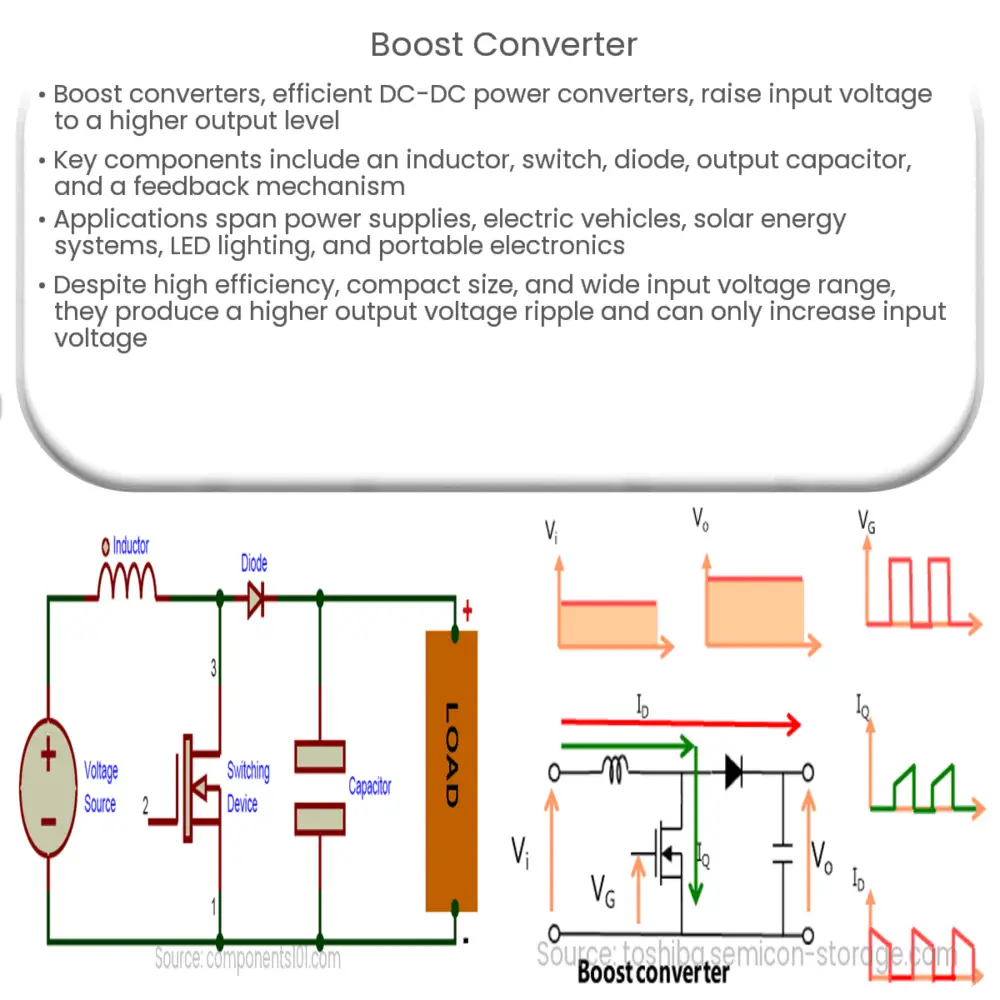Boost converters efficiently step up DC input voltage, offering high efficiency, compact size, and a wide input voltage range for various applications.

Boost Converter: An Introduction and Its Applications
Introduction
A boost converter is a type of DC-DC power converter that efficiently steps up input voltage to a higher output voltage level. It plays a crucial role in many electronic devices, from mobile phones to electric vehicles, where energy efficiency and voltage regulation are essential. This article will provide an overview of the basic principles behind the operation of a boost converter, its components, and its real-world applications.
How a Boost Converter Works
The fundamental principle of a boost converter lies in the energy storage and transfer capabilities of an inductor. When a voltage is applied across the inductor, a magnetic field is generated, storing energy within the inductor. When the voltage is removed, the magnetic field collapses, releasing the stored energy back to the circuit as an increased voltage.
A boost converter operates in two primary switching stages: the ON and OFF states. During the ON state, the input voltage is applied across the inductor, causing a current to flow through it and storing energy in its magnetic field. In this phase, the output capacitor supplies the load current. During the OFF state, the inductor is disconnected from the input voltage and connected to the output capacitor. The energy stored in the inductor is then transferred to the output capacitor, which charges up to a higher voltage level.
The process is controlled by a switch, typically a MOSFET, that alternates between the ON and OFF states at a specific switching frequency. By adjusting the duty cycle of the switch, the output voltage can be regulated to meet the desired level. A feedback mechanism, often a voltage comparator, monitors the output voltage and adjusts the duty cycle accordingly, ensuring a stable output voltage under varying load conditions.
Main Components of a Boost Converter
A boost converter consists of several key components:
- Inductor: A passive electronic component that stores energy in its magnetic field when a current passes through it.
- Switch: Typically a MOSFET, the switch alternates between the ON and OFF states, controlling the flow of current through the inductor and the energy transfer process.
- Diode: A semiconductor device that allows current to flow in one direction, preventing the output capacitor from discharging back into the inductor during the ON state.
- Output Capacitor: Stores the energy transferred from the inductor and provides a stable output voltage to the load.
- Feedback Mechanism: Monitors the output voltage and adjusts the duty cycle of the switch to maintain a stable output voltage under varying load conditions.
Applications of Boost Converters
Boost converters find widespread use in various industries and applications, thanks to their ability to efficiently step up voltage levels. Some common applications include:
- Power Supplies: Boost converters are used in power supplies for electronic devices, such as laptops and smartphones, to generate the required voltage levels for different components within the device.
- Electric Vehicles: In electric vehicles, boost converters are employed to increase the battery voltage to a higher level, suitable for driving the electric motor and other onboard systems.
- Solar Energy Systems: Boost converters are used in solar power systems to maximize power output by matching the panel’s output voltage to the battery bank’s optimal charging voltage.
- LED Lighting: LED lights require a constant current for proper operation. Boost converters are often utilized to step up the voltage in LED driver circuits, ensuring stable and efficient performance.
- Portable Electronics: Devices like portable chargers, power banks, and GPS units rely on boost converters to maintain a stable output voltage while drawing power from a lower-voltage battery source.
Advantages and Disadvantages of Boost Converters
Boost converters offer several advantages, making them an attractive choice for many applications:
- High Efficiency: Boost converters can achieve efficiencies of over 90% in certain conditions, making them ideal for energy-sensitive applications.
- Compact Size: Due to their relatively simple design and small number of components, boost converters can be easily integrated into compact electronic devices.
- Wide Input Voltage Range: Boost converters can accommodate a broad range of input voltages, providing flexibility in various applications.
However, boost converters also have some disadvantages:
- Higher Output Ripple: Due to the inductor’s energy storage and transfer process, boost converters can generate a higher output voltage ripple compared to other converter types, which may require additional filtering to ensure stable operation.
- Output Voltage Limitations: Boost converters can only increase the input voltage, meaning they cannot provide a lower output voltage or produce a negative voltage. For applications requiring bidirectional voltage conversion, other converter types, such as buck-boost converters, may be more suitable.
Conclusion
Boost converters are versatile and efficient DC-DC power converters that play a critical role in a wide range of applications. By understanding the principles behind their operation, their components, and their advantages and disadvantages, engineers and designers can leverage the benefits of boost converters to create efficient, reliable, and compact electronic devices and systems.

